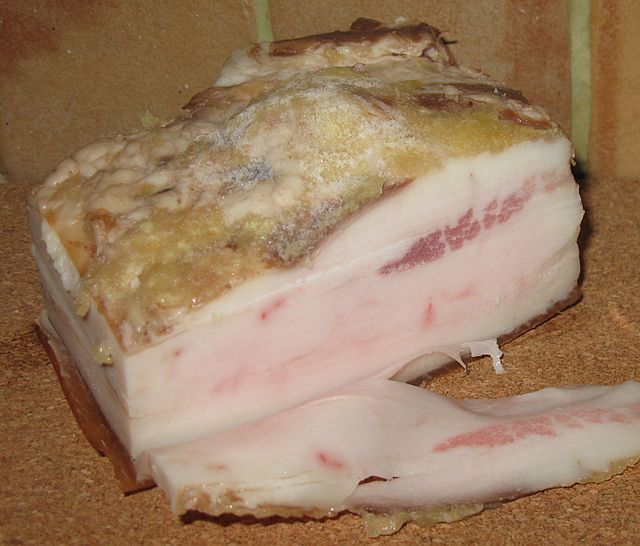Salo (food): Difference between revisions - Wikipedia
 Article Images
Article Images
Line 33:
[[File:Slonina.JPG|thumb|A slab of ''slanina'' aged in [[paprika]], popular in Eastern Europe]]
'''Salo''' or '''slanina''' ([[Russian language|Russian]] and [[Ukrainian language|Ukrainian]]: сало, [[Belarusian language|Belarusian]]: сала, [[Hungarian language|Hungarian]]: szalonna, [[Polish language|Polish]]: słonina, {{lang-ro|slănină}}, [[Czech language|Czech]] and [[Slovak language|Slovak]]: slanina, Carpatho-Rusyn: солонина/solonyna, {{lang-lt|lašiniai}}, [[Bulgarian language|Bulgarian]] and [[Serbo-Croatian language|Serbo-Croatian]]: сланина/slanina) is an Eastern European food consisting of cured slabs of [[fatback]] with or without skin. It is commonly eaten and known under different names across Eastern and Southeastern Europe, and is traditional to multiple national cuisines in the region. It is usually dry salt or [[brine]] [[curing (food preservation)|cured]]. The East Slavic, Hungarian and Romanian variety is sometimes treated with [[paprika]] or other seasonings, while the South and West Slavic version is often [[Smoking (cooking)|smoked]].
The Slavic word "salo" or "slanina" as applied to this type of food is often translated to English as "[[bacon]]" or "[[lard]]". Unlike lard, salo is not [[Rendering (food processing)|rendered]], and unlike bacon, salo also has little or no lean meat. It is similar to Italian ''[[lardo]]'', the main differences being the thickness of the cut (''lardo'' is often sliced very thinly) and seasoning. [[East SlavUkrainian]]ic salo uses salt, garlic, black pepper and sometimes [[coriander]] in the curing process, while ''lardo'' is generally seasoned with [[rosemary]] and other herbs.
==Preservation==
For preservation, salo is salted and sometimes also smoked and aged in a dark and cold place, where it will last for a year or more. The slabs of fat are first cut into manageable pieces, typically 15×20 cm. Then layers of fat slabs (skin side down) topped with one-centimetre layers of salt go into a wooden box or barrel for curing. For added flavouring and better preservation, the salo may be covered with a thick layer of [[paprika]] (usually in the more Western lands; in Russian salo with paprika is called "Hungarian"), minced [[garlic]], or sometimes [[black pepper]].{{Cn|date=August 2021}}
When salo has been aged too long or exposed to light, the fat may oxidize on the surface and become rancid, yellow and bitter-tasting. Though no longer fit for culinary use, the spoiled fat can be used as a water-repellent treatment for leather boots or bait for [[mouse trap]]s, or it can simply be turned into homemade [[soap]].{{Cn|date=August 2021}}
Line 45:
[[File:Salo.JPG|200px|thumb|''Lašiniai'', a Lithuanian type of salo]]
{{Unreferenced section|date=August 2021}}
Salo is consumed both raw and cooked. It is often fried or finely chopped with garlic as a condiment for [[borscht]] (beet soup). Small pieces of salo are added to some types of [[sausage]]. Thinly sliced salo on [[rye bread]] rubbed with [[garlic]] is a traditional snack to accompany [[vodka]] in Russia and [[horilka]] in Ukraine, where it is a particular favorite.
Salo is often chopped into small pieces and fried to render fat for [[cooking]], while the remaining [[Pork rind|cracklings]] ({{lang|uk-Latn|[[Čvarci|shkvarky]]}} in Ukrainian, {{lang|ru|shkvarki}} in Russian, {{lang|lt|spirgai}} in Lithuanian, {{lang|pl|skwarki}} in Polish, {{lang|cs|škvarky}} in Czech, (o){{lang|sk|škvarky}} in Slovak, {{lang|ro|jumări}} in Romanian, {{lang|et|kõrned}} in [[Estonian language|Estonian]], töpörtyű in Hungarian, пръжки or джумерки in Bulgarian) are used as condiments for fried [[potatoes]] or [[varenyky]] or spread on bread as a snack.
The thick pork skin that remains after the fat has been consumed is often used to make stock for soup or borscht. After boiling, the rind is often discarded. If soft enough, however, it is sometimes chopped or ground with salo, herbs, and spices and then spread on bread.
Line 79:
{{DEFAULTSORT:Salo (Food)}}
[[Category:Ukrainian cuisine]]
[[Category:Slavic cuisine]]
[[Category:Animal fat products]]